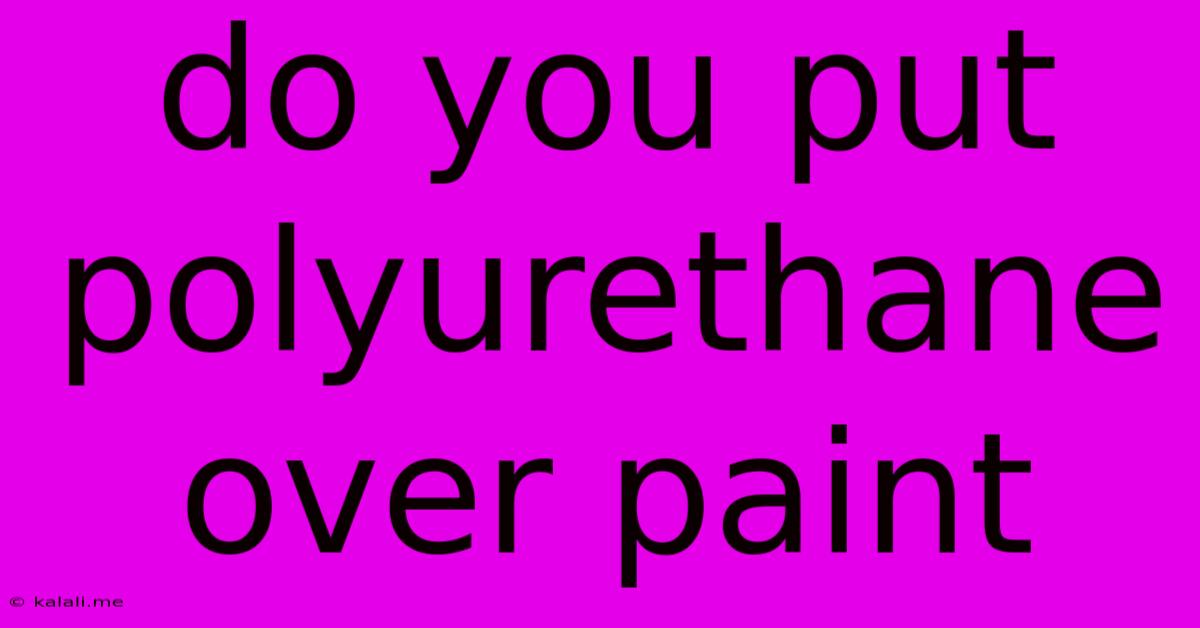Do You Put Polyurethane Over Paint
Kalali
Jun 03, 2025 · 4 min read

Table of Contents
Can You Put Polyurethane Over Paint? A Comprehensive Guide
Meta Description: Wondering if you can apply polyurethane over paint? This guide explores the pros, cons, and best practices for using polyurethane as a topcoat for painted surfaces, ensuring a durable and beautiful finish. Learn about compatibility, preparation, and application techniques to achieve professional results.
Applying polyurethane over paint is a common practice for enhancing the durability and protection of painted surfaces. Whether you're working on furniture, floors, or other projects, understanding the process is key to achieving a successful outcome. However, it's not a simple yes or no answer; several factors determine the feasibility and effectiveness of this approach. This comprehensive guide will walk you through everything you need to know.
Understanding Polyurethane and its Purpose
Polyurethane is a versatile protective coating known for its durability, water resistance, and scratch resistance. It comes in various forms, including oil-based, water-based, and spray-on options. Each type offers different properties and application methods. The choice depends on the surface being treated and the desired finish. Oil-based polyurethane tends to be more durable but requires more time to dry and has a stronger odor. Water-based polyurethane is easier to clean up and has a lower odor, but might not be as durable.
When Polyurethane Over Paint is a Good Idea
Polyurethane serves as an excellent topcoat for painted surfaces in several scenarios:
- Increased Durability: Adding a layer of polyurethane significantly increases the paint's resistance to scratches, abrasions, and wear and tear. This is particularly beneficial for high-traffic areas or items subject to frequent use.
- Enhanced Protection: Polyurethane creates a protective barrier against moisture, preventing damage from spills and humidity. This is vital for surfaces like kitchen countertops or bathroom vanities.
- Improved Appearance: A clear coat of polyurethane can enhance the shine and vibrancy of the underlying paint, giving it a professional, polished look. It can also help to even out the paint surface, minimizing imperfections.
- UV Protection: Some polyurethane formulations offer UV protection, preventing the paint from fading or yellowing over time, especially important for outdoor applications.
When Polyurethane Over Paint Might Not Be Ideal
While often beneficial, applying polyurethane over paint isn't always the best solution:
- Incompatible Paints: Certain paint types, like some chalk paints or highly porous paints, may not bond well with polyurethane, leading to peeling or bubbling. Always check the paint manufacturer's recommendations before applying a topcoat.
- Poorly Prepared Surfaces: If the underlying paint isn't properly prepared – clean, dry, and free from dust or debris – the polyurethane may not adhere correctly.
- Incorrect Polyurethane Choice: Using the wrong type of polyurethane for the project (e.g., using oil-based on a water-based paint) can lead to incompatibility issues.
- Already Damaged Paint: If the existing paint is already severely chipped, cracked, or peeling, applying polyurethane won't solve the underlying problems; you'll need to address the damage first.
Preparing the Surface for Polyurethane Application
Proper preparation is crucial for successful polyurethane application. Follow these steps:
- Clean the Surface: Thoroughly clean the painted surface to remove any dust, dirt, grease, or debris. Use a suitable cleaner, like mild soap and water, and allow it to dry completely.
- Sanding (Optional): Lightly sanding the painted surface can improve adhesion, particularly if the paint is glossy. Use fine-grit sandpaper (220-grit or higher) and remove any sanding dust with a tack cloth.
- Priming (If Necessary): If the paint is highly porous or absorbent, consider applying a primer before the polyurethane to ensure better adhesion.
- Allow Sufficient Drying Time: Ensure the underlying paint is completely dry before applying polyurethane. This drying time will vary depending on the type of paint used.
Applying Polyurethane: Techniques and Tips
The application method will vary depending on the type of polyurethane used. Always follow the manufacturer's instructions carefully. Generally:
- Thin Coats: Apply thin, even coats to avoid runs and drips. Multiple thin coats are better than one thick coat.
- Proper Ventilation: Ensure adequate ventilation when working with polyurethane, especially oil-based varieties.
- Brush, Roller, or Spray: Choose the application method that best suits your project and the type of polyurethane. For larger areas, a roller may be more efficient, while a brush allows for better control in detail work. Spray application offers a smooth finish but requires specialized equipment.
- Drying Time: Allow each coat to dry completely before applying the next. Drying time varies depending on the product and environmental conditions.
By following these guidelines, you can successfully apply polyurethane over paint, achieving a durable, protective, and beautiful finish. Remember to always prioritize proper surface preparation and choose the appropriate polyurethane for your specific project.
Latest Posts
Latest Posts
-
Does Lactose Free Milk Taste Different
Jun 05, 2025
-
How Long Were Israelites Slaves In Egypt
Jun 05, 2025
-
How To Get Toddler To Stay In Bed
Jun 05, 2025
-
Exposed Conductors In Contact With Each Other
Jun 05, 2025
-
Blessed Are Those Who Mourn Meaning
Jun 05, 2025
Related Post
Thank you for visiting our website which covers about Do You Put Polyurethane Over Paint . We hope the information provided has been useful to you. Feel free to contact us if you have any questions or need further assistance. See you next time and don't miss to bookmark.